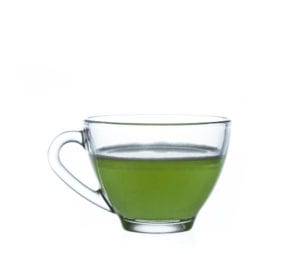Written by Angeline A. De Leon, Staff Writer. Drinking a tea catechin and caffeine containing beverage significantly increased energy expenditure by activating brown adipose tissue in participating subjects. As well, longer term daily ingestion of a catechin beverage chronically elevated cold-induced thermogenesis in participating subjects but not in the control group.
 Unlike white adipose tissue, brown adipose tissue (BAT) has been classified as a “good fat”, primarily for its role in converting food into body heat (metabolic thermogenesis) 1. BAT thermogenesis is triggered by exposure to cold temperatures, and higher BAT activity has been linked to increased energy expenditure (EE), improved insulin resistance, and lower adipose tissue 2,3. Interestingly, oral ingestion of certain food ingredients, such as capsaicin (active component of chili peppers) and green tea catechin (natural antioxidant), show a capacity for mimicking the cold-induced activation of BAT thermogenesis 4,5. Caffeine, as well, is highly recognized for its metabolism-boosting thermogenic effects in humans 6. In a research study published in the American Journal of Clinical Nutrition (2017), American researchers examined the acute and chronic effects of catechin and caffeine on whole-body EE and BAT activity using green tea extract.
Unlike white adipose tissue, brown adipose tissue (BAT) has been classified as a “good fat”, primarily for its role in converting food into body heat (metabolic thermogenesis) 1. BAT thermogenesis is triggered by exposure to cold temperatures, and higher BAT activity has been linked to increased energy expenditure (EE), improved insulin resistance, and lower adipose tissue 2,3. Interestingly, oral ingestion of certain food ingredients, such as capsaicin (active component of chili peppers) and green tea catechin (natural antioxidant), show a capacity for mimicking the cold-induced activation of BAT thermogenesis 4,5. Caffeine, as well, is highly recognized for its metabolism-boosting thermogenic effects in humans 6. In a research study published in the American Journal of Clinical Nutrition (2017), American researchers examined the acute and chronic effects of catechin and caffeine on whole-body EE and BAT activity using green tea extract.
Two independent, randomized, single-blinded, placebo-controlled, season-matched, cross-over trials were conducted, one assessing the acute impact of tea catechin supplementation, the other assessing its chronic effects. In the first trial, a total of 15 healthy young male volunteers were evaluated on BAT activity using fluorodeoxyglucose-positron emission tomography (PET) scan. Participants orally ingested a single serving of either a green tea beverage (containing 615 mg catechin and 77 mg caffeine) or a placebo beverage (containing 81 mg caffeine only), and EE was recorded based on an oxygen consumption and carbon dioxide production test. Ten subjects with low BAT activity were rolled over into the second trial and were randomized to receive either the green tea beverage or placebo twice daily for 5 weeks, with an 11-month washout period separating the two arms of the study. Before and after treatment, cold-induced thermogenesis (CIT) was measured after two hours of cold exposure at 19°C as an alternative, noninvasive predictive index of BAT activity.
Trial 1: Analyses revealed that a single ingestion of the caffeinated catechin beverage produced a slight but significant increase of EE only in those with metabolically active BAT (15.24 +/- 1.48 kcal, p < 0.01). Multivariate regression analyses confirmed a significant interaction between BAT and catechin on EE (β = 0.496, p = 0.003).
Trial 2: Longer-term daily ingestion of catechins, but not placebo, was found to increase average CIT activity (92.0 +/- 26.5 vs. 197.9 +/- 27.7 kcal/d, p = 0.009). Although no significant changes in anthropometric measurements were observed at the end of 5 weeks, cold-induced fat oxidation (calculated based on respiratory measures) was notably higher in subjects after ingestion of the catechin beverage (22.8 +/- 3.8 mg/min vs. 33.7 +/- 4.8 mg/min, p = 0.042).
Evidence suggests that oral supplementation with tea catechin and caffeine can acutely elevate whole body energy expenditure by engaging BAT thermogenesis. Sustained intake is associated with increased thermogenic capacity during mild cold exposure, signifying the potential for tea catechin to recruit BAT activity with chronic use. In sum, dietary interventions targeting the activation of BAT should consider tea catechin and caffeine as potential agents.
Source: Yoneshiro T, Matsushita M, Hibi M, et al. Tea catechin and caffeine activate brown adipose tissue and increase cold-induced thermogenic capacity in humans. Am J Clin Nutr. 2017; 105; 873-881.
© 2017 American Society for Nutrition
Posted December 5, 2017.
References:
- Kajimura S, Saito M. A new era in brown adipose tissue biology: molecular control of brown fat development and energy homeostasis. Annual review of physiology. 2014;76:225-249.
- van der Lans AA, Hoeks J, Brans B, et al. Cold acclimation recruits human brown fat and increases nonshivering thermogenesis. The Journal of clinical investigation. 2013;123(8):3395.
- Lee P, Smith S, Linderman J, et al. Temperature-acclimated brown adipose tissue modulates insulin sensitivity in humans. Diabetes. 2014:DB_140513.
- Yoneshiro T, Aita S, Kawai Y, Iwanaga T, Saito M. Nonpungent capsaicin analogs (capsinoids) increase energy expenditure through the activation of brown adipose tissue in humans. The American journal of clinical nutrition. 2012;95(4):845-850.
- Dulloo AG, Duret C, Rohrer D, et al. Efficacy of a green tea extract rich in catechin polyphenols and caffeine in increasing 24-h energy expenditure and fat oxidation in humans. The American journal of clinical nutrition. 1999;70(6):1040-1045.
- Dulloo A, Seydoux J, Girardier L, Chantre P, Vandermander J. Green tea and thermogenesis: interactions between catechin-polyphenols, caffeine and sympathetic activity. International journal of obesity. 2000;24(2):252.

